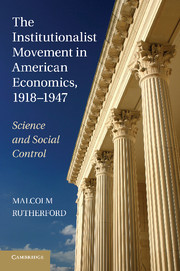Book contents
- Frontmatter
- Contents
- List of Tables
- Acknowledgments
- PART ONE INTRODUCTION
- PART TWO INSTITUTIONALIST CAREERS
- PART THREE CENTERS OF INSTITUTIONAL ECONOMICS
- PART FOUR CHALLENGES AND CHANGES
- PART FIVE CONCLUSION
- 12 Institutionalism in Retrospect
- Archive Collections Consulted
- References
- Index
- Titles in the series
12 - Institutionalism in Retrospect
Published online by Cambridge University Press: 03 May 2011
- Frontmatter
- Contents
- List of Tables
- Acknowledgments
- PART ONE INTRODUCTION
- PART TWO INSTITUTIONALIST CAREERS
- PART THREE CENTERS OF INSTITUTIONAL ECONOMICS
- PART FOUR CHALLENGES AND CHANGES
- PART FIVE CONCLUSION
- 12 Institutionalism in Retrospect
- Archive Collections Consulted
- References
- Index
- Titles in the series
Summary
The approach taken in this book is one that leads the historian of economics to think not just about the published literature associated with a particular group, but with a much broader range of issues – the network of individual contacts between members of the group, the university departments that were centers for them, the research organizations and agencies that supported their work, their contacts with government and government agencies, of where they found jobs for their students, their contacts with related disciplines and intellectual developments elsewhere, and, most important of all, the often contested nature of what is to count as good science. Looking back at the history of the institutionalist movement from its inception in around 1918 until 1947 in this way, we can understand the original appeal of the movement and what its primary elements consisted of; we can see the trajectory of the movement, both in general and in detail as reflected in particular careers and at particular institutions; and we can see the reasons for its loss of status and appeal in the 1940s.
INSTITUTIONALISM'S EARLY APPEAL
At its beginning, institutionalism promised much. Hamilton's 1918 manifesto was an ambitious one. At that time, however, “orthodox” economics was relatively weak, seemingly incapable of dealing with the new problems and issues of an industrial America. But institutionalism was more than just a response to orthodox weakness.
- Type
- Chapter
- Information
- The Institutionalist Movement in American Economics, 1918–1947Science and Social Control, pp. 345 - 354Publisher: Cambridge University PressPrint publication year: 2011

